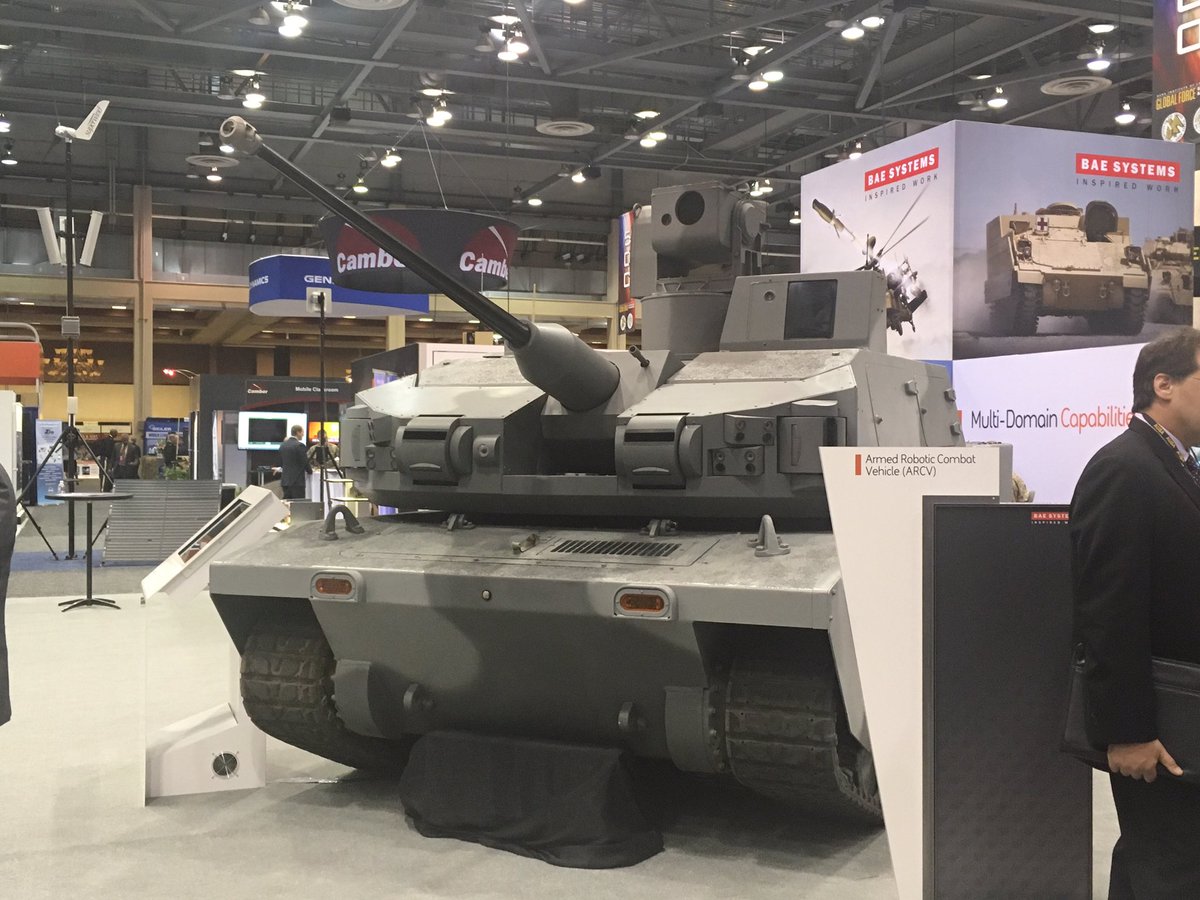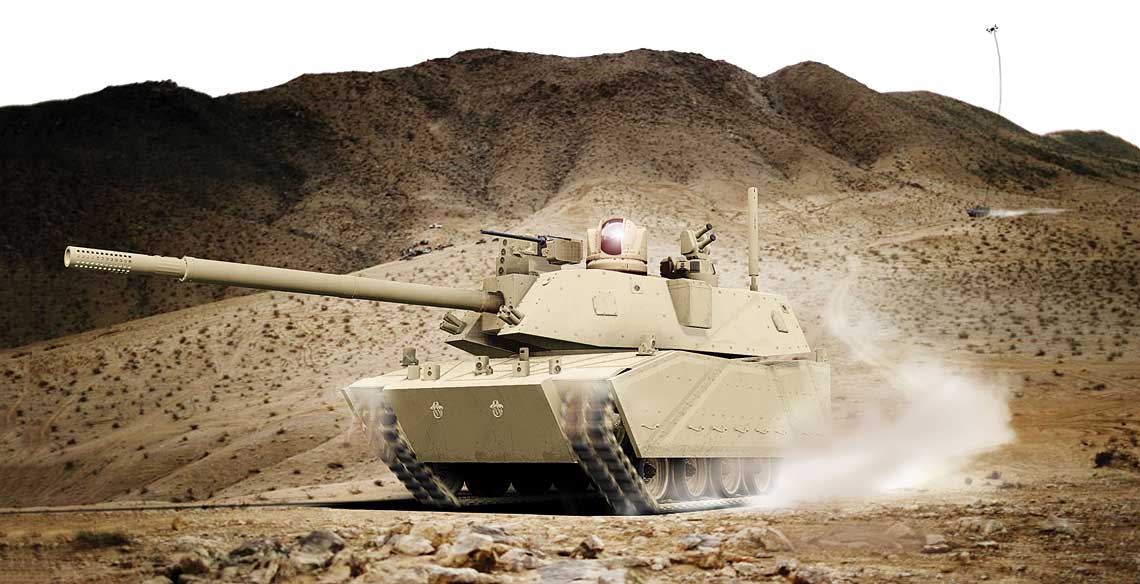
AUSA Global Force 2018 - about the future of the US Army

Perhaps this is what a tank based on the NGCV, the successor to the Abrams, will look like.
The AUSA Global Force Symposium was held at the Von Braun Center in Huntsville, Alabama March 26-28. The purpose of the organizer of this annual event is to present the direction of the development of the US Army and related concepts. This year the main topics were unmanned combat vehicles and artillery.
Founded in 1950, AUSA (United States Army Association) is a non-governmental organization dedicated to providing various support to the US Army, aimed at soldiers and civil servants, as well as politicians and defense industry representatives. The statutory tasks include: educational activities (the meaning and form of modern ground warfare in the context of the tasks of the US Army), information (dissemination of knowledge about the US Army) and communication (between the US Army and the rest of society). and US state). 121 institutions, also located outside the United States, donate $5 million annually to awards, scholarships, and support for soldiers and their families. The values promoted by the organization are: innovation, professionalism, integrity, responsiveness, the pursuit of excellence, and the connection between the US military and the rest of American society. AUSA Global Force is one of the opportunities to spread such knowledge, including about the US Army, with a special focus on development directions in response to the tasks assigned to its soldiers. The location is no coincidence - there are 909 branches of various enterprises participating in defense programs worth $5,6 billion near Huntsville. The theme of this year's project was "Modernizing and Equipping the American Army Today and Tomorrow."
Big six (and one)
The future of the US Army is firmly tied to the so-called Big Six plus One (literally Big 6+1). This is a clear reference to the American "big five" (Big 5) of the turn of the 70s and 80s, which included: a new tank (M1 Abrams), a new infantry fighting vehicle (M2 Bradley), a new multi-purpose helicopter (UH-60 Black Hawk), a new combat helicopter (AH-64 Apache) and a Patriot anti-aircraft missile system. Today, the Big Six consists of: a family of new helicopters (Future Vertical Lift), new combat vehicles (especially the AMPV, NGCV / FT and MPF programs), air defense, battlefield control (especially during foreign missions, including electronic and warfare in cyberspace) and autonomous and remotely controlled. All of them must cooperate within the framework of the so-called. Multi-domain battle, that is, the use of combined maneuvering forces to create a temporary advantage in several areas to capture, maintain and use the initiative. Where is the One referred to in all this? Despite advances in electronics, communications, firepower, armor, and mobility, the core of the army is still the soldier: their skills, equipment, and morale. These are the main areas of interest to American planners, and related to them, the most important modernization programs for the US Army in both the short and very long term. Despite the definition of a "road map" for the US Army several years ago (for example, the 2014 Combat Vehicle Modernization Strategy), the construction of the "road" itself has not yet been completed, as will be discussed below.
To more effectively manage the Big Six projects, on October 3, 2017, a new command with a very meaningful name, Future Command, was created in the US Army. It is divided into six interdisciplinary CFT (Cross Functional Team) working groups. Each of them, under the command of an officer with the rank of brigadier general (with combat experience), includes specialists in various fields. The formation of the team was to be completed in 120 days from October 9, 2017. Thanks to CFT, the US Army modernization process should be faster, cheaper and more flexible. At present, the role of the CFT is limited to the compilation of specific "wish lists" that are crucial for each of the main areas of modernization of the US Army. They are also, admittedly, along with traditional agencies such as TRADOC (U.S. Army Training and Doctrine Command) or ATEC (U.S. Army Test and Evaluation Command), responsible for conducting weapons testing. However, over time, their importance may increase, which largely depends on the results of their work.
Unmanned combat vehicles - the future today or the day after tomorrow?
The NGCV program (a potential successor to the BMP M2, replacing the GCV and FFV programs, respectively) and the closely related "unmanned wingman" are of key importance for the development of US Army combat vehicles. During a panel on the topics discussed here during AUSA Global Force 2018, Gen. Brig. David Lesperance, responsible for the development of new combat platforms for the US Army (CFT NGCV leader). According to him, it has been announced since 2014. The "unmanned wingman" robot wingman) will be ready for military evaluation in 2019 in parallel with the new infantry fighting vehicle. Then the first prototypes (more precisely, technology demonstrators) of the NGCV 1.0 and the "unmanned wingman" will be delivered for testing under the auspices of ATEC. Trials are scheduled to begin in the first quarter of fiscal year 2020 (October-December 2019) and be completed in 6-9 months. Their most important goal is to check the currently available level of “insecurity” of vehicles. The US$700 million contract is to result in several concepts, some of which will be specified by Gen. Mark Milley, US Army Chief of Staff, for further development. The companies are working on the project as part of a team led by Science Applications International Corp. (behind Lockheed Martin, Moog, GS Engineering, Hodges Transportation and Roush Industries). Lessons learned from the testing of the first prototypes will be used to reconfigure and build the next prototypes under the 2022 and 2024 tax year budgets. The second phase will run through fiscal 2021-2022 and five teams will prepare three concepts each: one based on user input, one modified using parallel emerging technical solutions, and one with some flexibility suggested by the bidder. Concepts will then be selected and prototypes built. This time it will be the responsibility of the bidder to provide two manned and four unmanned vehicles operating together as part of a Centaur platoon (or, less poetically, a manned-unmanned formation), from a combination of man and machine (this time not a horse). Testing will begin in the third quarter of 2021. and will last until the end of 2022. The third phase is planned for fiscal years 2023-2024. This time, the tests will take place at the company level with seven manned (NGCV 2.0) and 14 unmanned vehicles. These will be the most brutal and realistic battlefields in a series of challenges starting in the first quarter of 2023. The “fluid” structure of the procedure is very interesting: if a given company is eliminated at an earlier stage, it can still apply for participation in the next stage. Another interesting fact is that if the US Army considers the vehicles tested in Phase I (or Phase II) suitable, then after its completion, contracts can be expected to complete the R&D phase and, therefore, orders. The Wingman robot will be created in two stages: the first by 2035. as a semi-autonomous vehicle and the second, in 2035-2045, as a fully autonomous vehicle. It should be remembered that the “unmanned winged aircraft” program is burdened with high risks, which many experts emphasize (for example, problems with artificial intelligence or remote control under the influence of electronic warfare). Therefore, the US Army is not required to make a purchase, and the R&D phase can be extended or even closed. This is in stark contrast to, for example, the Future Combat Systems program, which ended in 2009 after spending $18 billion without providing US troops with a single regular service vehicle. In addition, the intended pace of work and the flexible approach to the program are in stark contrast to the FCS, which was canceled due to ever-increasing complications (but also irrational assumptions). Simultaneously with the development of machines, their role on the battlefield will be clarified: whether tracked robots will be auxiliary or reconnaissance or combat vehicles, time will tell. It is worth remembering that work on autonomous military vehicles has been underway in the United States for some time.

